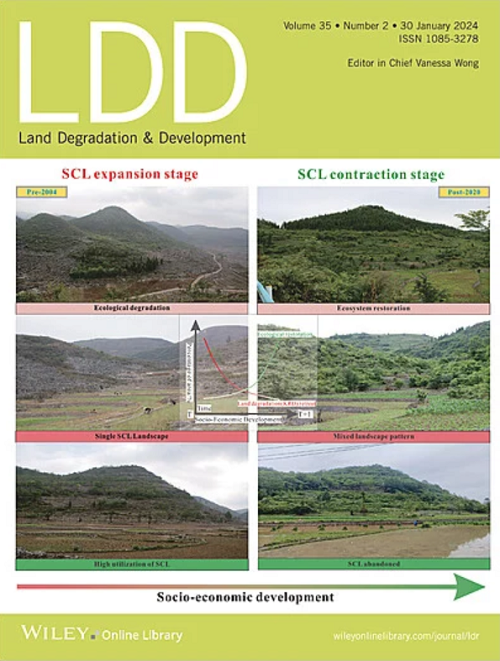博斯腾湖湿地生态系统健康时空变化及驱动力分析
IF 3.6
2区 农林科学
Q2 ENVIRONMENTAL SCIENCES
引用次数: 0
摘要
湿地在维持当地生态系统方面发挥着至关重要的作用,具有重要的生态和经济价值,特别是在水资源保护和气候调节方面。然而,由于野外观测数据在大尺度时空分析中的局限性,目前干旱区内陆湿地健康评价框架尚不完善。为了解决这一问题,我们提出了一个基于遥感数据的湿地生态系统健康评价系统。该系统能够对干旱区内陆湿地的空间结构变化、景观格局和空间连通性等复杂而相互关联的特征进行评价。该方法克服了野外数据的时空限制,为湿地保护与管理、湿地资源的合理开发与可持续利用提供了理论支持,从而为应对湿地生态系统面临的挑战提供了有效的策略。以博斯腾湖湿地为研究区,构建了基于土地利用土地覆盖(LULC)数据集、人为因素、生态要素和地形的湿地生态系统健康评价体系。采用压力-状态-响应(PSR)模型、景观指数、层次分析法(AHP)、湿地生态系统健康指数(WEHI)、Theil-Sen坡度估算、Mann-Kendall趋势分析和地理探测器等方法,研究了湿地生态系统健康的时空特征、健康水平的转变、健康变化的趋势及其驱动力。结果表明:(1)2000 - 2020年,博斯腾湖湿地健康水平呈下降-增长-下降-增长的波动型格局。湖泊区域的WEHI高于湖滨和边缘区域,小湖区域的WEHI相对较高。健康区面积扩大,非健康区面积减少。(2) 2000-2020年湿地生态系统健康状况显著改善的区域主要集中在大湖区西部和小湖区,湖周周边略有恶化。(3)影响博斯腾湖湿地健康的关键因子包括生态系统服务价值(ESV)、国内生产总值(GDP)、最大斑块指数(LPI)和人口(POP)。相比之下,坡度和夜间灯光(NTL)的影响最小。ESV与LSI、GDP或Shannon多样性指数(SHDI)之间的交互作用对湿地生态系统影响较大。本文章由计算机程序翻译,如有差异,请以英文原文为准。
Spatiotemporal Variations and Driving Forces Analysis of Ecosystem Health in the Bosten Lake Wetland in China
Wetlands play a crucial role in maintaining local ecosystems, offering significant ecological and economic value, especially in water conservation and climate regulation. However, due to the limitations of field observation data in large‐scale spatiotemporal analyses, current health assessment frameworks for inland wetlands in arid regions remain underdeveloped. To address this gap, we propose a wetland ecosystem health assessment system based on remote sensing data. This system enables the evaluation of complex and interrelated characteristics such as spatial structure changes, landscape patterns, and spatial connectivity in inland wetlands in arid areas. By overcoming the spatiotemporal constraints of field data, our approach provides theoretical support for wetland protection and management, as well as for the rational development and sustainable utilization of wetland resources, thereby offering effective strategies to tackle the challenges facing wetland ecosystems. This study focuses on the Bosten Lake wetland as the research area, constructing a wetland ecosystem health assessment system based on the Land Use Land Cover (LULC) dataset, anthropogenic factors, ecological elements, and topography. Using the pressure‐state‐response (PSR) model, landscape indices, analytic hierarchy process (AHP), wetland ecosystem health index (WEHI), Theil–Sen slope estimation, Mann–Kendall (MK) trend analysis, and geographical detector methods, we investigated the spatiotemporal characteristics of ecosystem health, transitions in health levels, trends in health changes, and their driving forces. The findings are as follows: (1) From 2000 to 2020, the health level of the Bosten Lake wetland exhibited a wave‐like pattern of decline, growth, decline, and growth. The WEHI in the lake region was higher compared to the lakeshore and marginal areas, while the small lake areas tend to have relatively higher WEHI levels. The area of unhealthy regions decreased while the area of healthy regions expanded. (2) Significant improvement in the wetland ecosystem health during 2000–2020 was observed mainly in the western part of the large lake regions and the small lake regions, while slight deterioration was noted around the lake periphery. (3) The key factors influencing the health of the Bosten Lake wetland included ecosystem service value (ESV), gross domestic product (GDP), largest patch index (LPI), and population (POP). In contrast, slope and nighttime light (NTL) had minimal impact. Interactions between ESV and LSI, GDP, or Shannon diversity index (SHDI) strongly influenced the wetland ecosystem.
求助全文
通过发布文献求助,成功后即可免费获取论文全文。
去求助
来源期刊

Land Degradation & Development
农林科学-环境科学
CiteScore
7.70
自引率
8.50%
发文量
379
审稿时长
5.5 months
期刊介绍:
Land Degradation & Development is an international journal which seeks to promote rational study of the recognition, monitoring, control and rehabilitation of degradation in terrestrial environments. The journal focuses on:
- what land degradation is;
- what causes land degradation;
- the impacts of land degradation
- the scale of land degradation;
- the history, current status or future trends of land degradation;
- avoidance, mitigation and control of land degradation;
- remedial actions to rehabilitate or restore degraded land;
- sustainable land management.
 求助内容:
求助内容: 应助结果提醒方式:
应助结果提醒方式:


